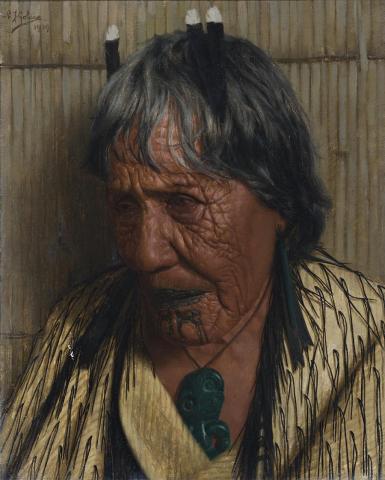TE AITU TE IRIKAU, (AN ARAWA CHIEFTAINESS), 1919
Charles Frederick Goldie
oil on canvas
27.0 x 21.5 cm
signed and dated upper left: C.F.Goldie / 1919
inscribed on frame verso (indistinct)
John Leech Gallery, Auckland (label attached verso)
The Austin Family, nr Boggabri, NSW (since c.1950)
Thence by descent
Elizabeth Austin, Sydney
Private collection, Sydney (a gift from the above)
Te Aitu Te Irikau, an Arawa Chieftainess, 1916, oil on canvas, 20.6 x 20.5 cm, private collection
‘Reverie’ - Te Aitu Te Irikau (an Arawa Chieftainess), Auckland Society of Arts, 1919, cat. 125
Charles Frederick Goldie, who specialised in painting portraits of the Maori people of New Zealand, has something of an old master status in his home country. While his career experienced fluctuating fortunes, it is significant that his work is highly respected by many Maori people, who ‘revere the depictions of their ancestors…’1 The reasons for this reverence are clearly apparent in Te Aitu Te Irikau (an Arawa Chieftainess) 1919, a characteristic work which combines an awe-inspiring realism with a regard that touches upon deference. His early artistic ability and extraordinary eye for detail led him to Paris where he studied at the Académie Julian and elsewhere, copying old masters in the Louvre, and coming under the influence of such academic figures as William-Adolphe Bouguereau. His return to Auckland in 1898 was marked by collaboration with L. J.Steele on the painting The Arrival of the Maoris in New Zealand (Auckland Art Gallery Toi o Tamaki). Indicative of his growing interests, it was based on Théodore Géricault's politically controversial The Raft of the Medusa, translated into the sea worn Polynesians sighting their new homeland. Not unlike Frederick McCubbin and his desire to record the Australian pioneers, Goldie devoted himself to the historically important task of painting portraits of the old Maoris before they were all gone. Overcoming initial concerns, they soon readily posed for him, Goldie making pencil sketches, colour notes and photographs to aid him in his demanding accuracy. His considerable achievement is seen in the way in which he captured both likeness and character, detailing tattoos, textures of skin, hair and clothing. Given his particular task, most of his subjects were elderly, important figures in their society, and usually beautifully tattooed. This was important because tattooing was dying out. His figures were often presented in native dress, their looks reflective, perhaps of a time now passed. A more mundane though practical reason is that his sitters often fell asleep while posing, the metaphoric implications of sleep not being missed by the artist.
These interests are taken up in Te Aitu Te Irikau (an Arawa Chieftainess), Goldie's linear mastery inter-relating the aged lines of a face of considerable dignity with the tattooed chin, decoration of the native dress, and timbered background, a classic example of his ability to create overall harmony amid the splendour of detail. A variant of this painting, ‘Reverie’ - Te Aitu Te Irikau (an Arawa Chieftainess), was shown at the Auckland Society of Arts exhibition in 1919. The subject must have had a particular appeal, for a few years before, in 1916 he had painted another commanding portrait of this noble Maori elder.
1. Blackley, R., Goldie, Auckland Art Gallery in association with David Bateman Ltd, Auckland, 1997, p. 1
DAVID THOMAS
